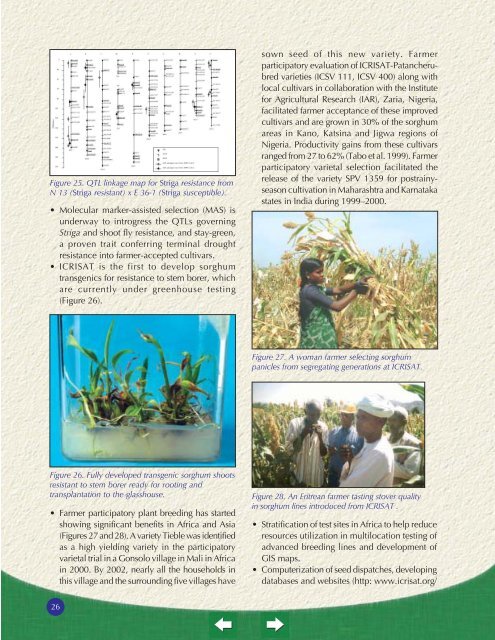Sorghum - icrisat
Sorghum - icrisat
Sorghum - icrisat
Create successful ePaper yourself
Turn your PDF publications into a flip-book with our unique Google optimized e-Paper software.
Figure 25. QTL linkage map for Striga resistance from<br />
N 13 (Striga resistant) x E 36-1 (Striga susceptible).<br />
• Molecular marker-assisted selection (MAS) is<br />
underway to introgress the QTLs governing<br />
Striga and shoot fly resistance, and stay-green,<br />
a proven trait conferring terminal drought<br />
resistance into farmer-accepted cultivars.<br />
• ICRISAT is the first to develop sorghum<br />
transgenics for resistance to stem borer, which<br />
are currently under greenhouse testing<br />
(Figure 26).<br />
sown seed of this new variety. Farmer<br />
participatory evaluation of ICRISAT-Patancherubred<br />
varieties (ICSV 111, ICSV 400) along with<br />
local cultivars in collaboration with the Institute<br />
for Agricultural Research (IAR), Zaria, Nigeria,<br />
facilitated farmer acceptance of these improved<br />
cultivars and are grown in 30% of the sorghum<br />
areas in Kano, Katsina and Jigwa regions of<br />
Nigeria. Productivity gains from these cultivars<br />
ranged from 27 to 62% (Tabo et al. 1999). Farmer<br />
participatory varietal selection facilitated the<br />
release of the variety SPV 1359 for postrainyseason<br />
cultivation in Maharashtra and Karnataka<br />
states in India during 1999–2000.<br />
Figure 27. A woman farmer selecting sorghum<br />
panicles from segregating generations at ICRISAT.<br />
Figure 26. Fully developed transgenic sorghum shoots<br />
resistant to stem borer ready for rooting and<br />
transplantation to the glasshouse.<br />
• Farmer participatory plant breeding has started<br />
showing significant benefits in Africa and Asia<br />
(Figures 27 and 28). A variety Tieble was identified<br />
as a high yielding variety in the participatory<br />
varietal trial in a Gonsolo village in Mali in Africa<br />
in 2000. By 2002, nearly all the households in<br />
this village and the surrounding five villages have<br />
Figure 28. An Eritrean farmer tasting stover quality<br />
in sorghum lines introduced from ICRISAT .<br />
• Stratification of test sites in Africa to help reduce<br />
resources utilization in multilocation testing of<br />
advanced breeding lines and development of<br />
GIS maps.<br />
• Computerization of seed dispatches, developing<br />
databases and websites (http: www.<strong>icrisat</strong>.org/<br />
26
















